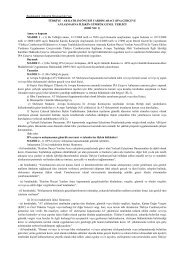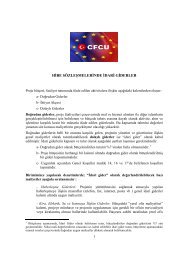Project Cycle Management Training Handbook - CFCU
Project Cycle Management Training Handbook - CFCU
Project Cycle Management Training Handbook - CFCU
You also want an ePaper? Increase the reach of your titles
YUMPU automatically turns print PDFs into web optimized ePapers that Google loves.
<strong>Project</strong> <strong>Cycle</strong> <strong>Management</strong> <strong>Training</strong> <strong>Handbook</strong><br />
7.3.2 Activities<br />
Actual schedule and completion compared with plan. Were there<br />
delays or time savings? Which organisation was responsible for<br />
delays? What effect did deviations from plan have on the project?<br />
These data will have been monitored and reported in progress reports.<br />
Figure 33: Linking Indicators to the Logframe<br />
Indicators & the logframe<br />
Level of logframe Type of information Timing of collection Measurement concept<br />
Overall Objectives Substantive development change specific to the sector.<br />
Measurements based on trends, possibly of key sectoral indicators<br />
NOTE: the project is only one of many factors influencing change<br />
<strong>Project</strong> Purpose Realistic & sustainable change in target group situation, specific to<br />
project intervention<br />
Beneficiary<br />
response<br />
Early warning of likelihood of implementation success from opinions<br />
of beneficiaries about their access to, use of, and degree of<br />
satisfaction with services provided by the project<br />
Results Quantitative and qualitative measures of physical progress in service<br />
delivery<br />
Cost ratios and input output ratios of performance<br />
Comparisons of actual achievements with planned targets<br />
Activities Measures based on activity schedule<br />
Comparisons of actual start and completion dates with planned dates<br />
Variations from the planned schedule<br />
Milestone dates and events<br />
Costs Measures based on project budget<br />
Comparisons of actual against plan<br />
Analysis of government, donor and beneficiary contributions<br />
Cost variance analysis<br />
7.3.3 Results<br />
<strong>Project</strong> completion &<br />
ex-post<br />
Mid-term & project<br />
completion<br />
Quarterly/yearly<br />
[Collected as part of<br />
results-monitoring.]<br />
SUSTAINABILITY<br />
‘Continuing the flow of benefits.’<br />
IMPACT<br />
‘Making a difference<br />
in the wider environment.’<br />
RELEVANCE<br />
‘Meeting target group needs.’<br />
LEADING INDICATORS<br />
Proxies for relevant and sustainable<br />
change<br />
Quarterly/yearly EFFECTIVENESS<br />
‘Progress towards objectives<br />
- doing the right things.’<br />
EFFICIENCY<br />
‘Efficient implementation<br />
- doing things right.’<br />
Weekly/Monthly<br />
Weekly/Monthly<br />
ECONOMY<br />
‘Ensuring the best relationship between<br />
cost, quality & time.’<br />
Indicators of how activities were transformed into results and<br />
services. Many of these indicators will be process indicators that<br />
report successful completion of a task – eg. Business Centre<br />
established and equipped. Others will be quantified targets such as<br />
number of managers trained in market analysis. A third level is<br />
concerned with the efficiency of project activities.<br />
Efficiency indicators compare actual inputs as a ratio of actual<br />
outputs: e.g. average cost of training per participant; number of SMEs<br />
being advised per Business Adviser per month; percentage of<br />
retrained public sector workers finding jobs in the private sector. Most<br />
of these data will be obtainable from project records and will have<br />
been reported in progress reports. Calculation of these ratios will<br />
65





